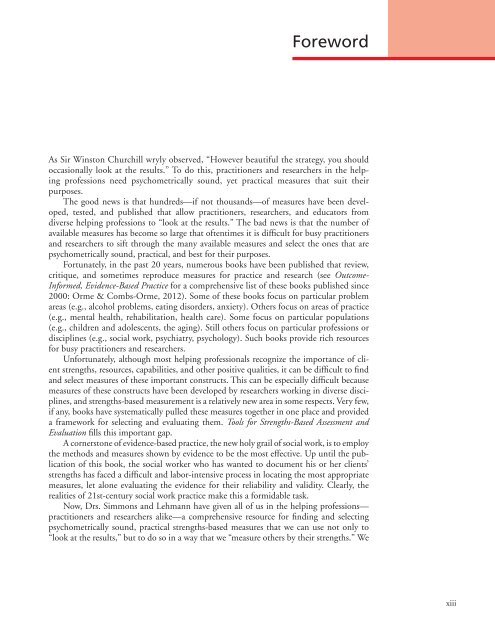Tools for Strengths-Based Assessment and Evaluation - Springer ...
Tools for Strengths-Based Assessment and Evaluation - Springer ...
Tools for Strengths-Based Assessment and Evaluation - Springer ...
Create successful ePaper yourself
Turn your PDF publications into a flip-book with our unique Google optimized e-Paper software.
Foreword<br />
As Sir Winston Churchill wryly observed, “However beautiful the strategy, you should<br />
occasionally look at the results.” To do this, practitioners <strong>and</strong> researchers in the helping<br />
professions need psychometrically sound, yet practical measures that suit their<br />
purposes.<br />
The good news is that hundreds—if not thous<strong>and</strong>s—of measures have been developed,<br />
tested, <strong>and</strong> published that allow practitioners, researchers, <strong>and</strong> educators from<br />
diverse helping professions to “look at the results.” The bad news is that the number of<br />
available measures has become so large that oftentimes it is difficult <strong>for</strong> busy practitioners<br />
<strong>and</strong> researchers to sift through the many available measures <strong>and</strong> select the ones that are<br />
psychometrically sound, practical, <strong>and</strong> best <strong>for</strong> their purposes.<br />
Fortunately, in the past 20 years, numerous books have been published that review,<br />
critique, <strong>and</strong> sometimes reproduce measures <strong>for</strong> practice <strong>and</strong> research (see Outcome-<br />
In<strong>for</strong>med, Evidence-<strong>Based</strong> Practice <strong>for</strong> a comprehensive list of these books published since<br />
2000: Orme & Combs-Orme, 2012). Some of these books focus on particular problem<br />
areas (e.g., alcohol problems, eating disorders, anxiety). Others focus on areas of practice<br />
(e.g., mental health, rehabilitation, health care). Some focus on particular populations<br />
(e.g., children <strong>and</strong> adolescents, the aging). Still others focus on particular professions or<br />
disciplines (e.g., social work, psychiatry, psychology). Such books provide rich resources<br />
<strong>for</strong> busy practitioners <strong>and</strong> researchers.<br />
Un<strong>for</strong>tunately, although most helping professionals recognize the importance of client<br />
strengths, resources, capabilities, <strong>and</strong> other positive qualities, it can be difficult to find<br />
<strong>and</strong> select measures of these important constructs. This can be especially difficult because<br />
measures of these constructs have been developed by researchers working in diverse disciplines,<br />
<strong>and</strong> strengths-based measurement is a relatively new area in some respects. Very few,<br />
if any, books have systematically pulled these measures together in one place <strong>and</strong> provided<br />
a framework <strong>for</strong> selecting <strong>and</strong> evaluating them. <strong>Tools</strong> <strong>for</strong> <strong>Strengths</strong>-<strong>Based</strong> <strong>Assessment</strong> <strong>and</strong><br />
<strong>Evaluation</strong> fills this important gap.<br />
A cornerstone of evidence-based practice, the new holy grail of social work, is to employ<br />
the methods <strong>and</strong> measures shown by evidence to be the most effective. Up until the publication<br />
of this book, the social worker who has wanted to document his or her clients’<br />
strengths has faced a difficult <strong>and</strong> labor-intensive process in locating the most appropriate<br />
measures, let alone evaluating the evidence <strong>for</strong> their reliability <strong>and</strong> validity. Clearly, the<br />
realities of 21st-century social work practice make this a <strong>for</strong>midable task.<br />
Now, Drs. Simmons <strong>and</strong> Lehmann have given all of us in the helping professions—<br />
practitioners <strong>and</strong> researchers alike—a comprehensive resource <strong>for</strong> finding <strong>and</strong> selecting<br />
psychometrically sound, practical strengths-based measures that we can use not only to<br />
“look at the results,” but to do so in a way that we “measure others by their strengths.” We<br />
xiii

















